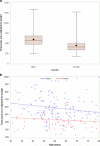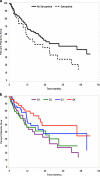Impact of sarcopenia on outcomes following intra-arterial therapy of hepatic malignancies
- PMID: 24065364
- PMCID: PMC3982291
- DOI: 10.1007/s11605-013-2348-5
Impact of sarcopenia on outcomes following intra-arterial therapy of hepatic malignancies
Abstract
Background: Assessment of patient performance status is often subjective. Sarcopenia--measurement of muscle wasting--may be a more objective means to assess performance status and therefore mortality risk following intra-arterial therapy (IAT).
Methods: Total psoas area (TPA) was measured on cross-sectional imaging in 216 patients undergoing IAT of hepatic malignancies between 2002 and 2012. Sarcopenia was defined as TPA in the lowest sex-specific quartile. Impact of sarcopenia was assessed relative to other clinicopathological factors.
Results: Indications for IAT included hepatocellular carcinoma (51 %), intrahepatic cholangiocarcinoma (13 %), colorectal liver metastasis (7 %), or other metastatic disease (30 %). Median TPA among men (568 mm(2)/m(2)) was greater than women (413 mm(2)/m(2)). IAT involved conventional chemoembolization (54 %), drug-eluting beads (40 %), or yttrium-90 (6 %). Median tumor size was 5.8 cm; most patients had multiple lesions (74 %). Ninety-day mortality was 9.3 %; 3-year survival was 39 %. Factors associated with risk of death were tumor size (HR = 1.84) and Child's score (HR = 2.15) (all P < 0.05). On multivariate analysis, sarcopenia remained independently associated with increased risk of death (lowest vs. highest TPA quartile, HR = 1.84; P = 0.04). Sarcopenic patients had a 3-year survival of 28 vs. 44 % for non-sarcopenic patients.
Conclusions: Sarcopenia was an independent predictor of mortality following IAT with sarcopenic patients having a twofold increased risk of death. Sarcopenia is an objective measure of frailty that can help clinical decision-making regarding IAT for hepatic malignancies.
Figures



Similar articles
-
Sarcopenia adversely impacts postoperative complications following resection or transplantation in patients with primary liver tumors.J Gastrointest Surg. 2015 Feb;19(2):272-81. doi: 10.1007/s11605-014-2680-4. Epub 2014 Nov 12. J Gastrointest Surg. 2015. PMID: 25389056 Free PMC article.
-
Intra-arterial therapy for advanced intrahepatic cholangiocarcinoma: a multi-institutional analysis.Ann Surg Oncol. 2013 Nov;20(12):3779-86. doi: 10.1245/s10434-013-3127-y. Epub 2013 Jul 12. Ann Surg Oncol. 2013. PMID: 23846786
-
Pre-operative Sarcopenia Identifies Patients at Risk for Poor Survival After Resection of Biliary Tract Cancers.J Gastrointest Surg. 2018 Oct;22(10):1697-1708. doi: 10.1007/s11605-018-3802-1. Epub 2018 May 31. J Gastrointest Surg. 2018. PMID: 29855867
-
Transarterial approaches to primary and secondary hepatic malignancies.Nat Rev Clin Oncol. 2015 Aug;12(8):481-9. doi: 10.1038/nrclinonc.2015.78. Epub 2015 May 19. Nat Rev Clin Oncol. 2015. PMID: 25985939 Review.
-
Intra-arterial therapies for unresectable and chemorefractory colorectal cancer liver metastases: a systematic review and meta-analysis.HPB (Oxford). 2018 Oct;20(10):905-915. doi: 10.1016/j.hpb.2018.04.001. Epub 2018 Jun 7. HPB (Oxford). 2018. PMID: 29887263
Cited by
-
Clinical impact of sarcopenia assessment in patients with hepatocellular carcinoma undergoing treatments.J Gastroenterol. 2020 Oct;55(10):927-943. doi: 10.1007/s00535-020-01711-w. Epub 2020 Aug 3. J Gastroenterol. 2020. PMID: 32748172 Free PMC article. Review.
-
Computed Tomography-Defined Sarcopenia in Outcomes of Patients with Unresectable Hepatocellular Carcinoma Undergoing Radioembolization: Assessment with Total Abdominal, Psoas, and Paraspinal Muscles.Liver Cancer. 2023 Feb 23;12(6):550-564. doi: 10.1159/000529676. eCollection 2023 Dec. Liver Cancer. 2023. PMID: 38058418 Free PMC article.
-
Sarcopenia and visceral adiposity predict poor overall survival in hepatocellular carcinoma patients after curative hepatic resection.Transl Cancer Res. 2021 Feb;10(2):854-866. doi: 10.21037/tcr-20-2974. Transl Cancer Res. 2021. PMID: 35116415 Free PMC article.
-
Macrophages protect against loss of adipose tissue during cancer cachexia.J Cachexia Sarcopenia Muscle. 2019 Oct;10(5):1128-1142. doi: 10.1002/jcsm.12450. Epub 2019 Jul 18. J Cachexia Sarcopenia Muscle. 2019. PMID: 31318182 Free PMC article.
-
Skeletal muscle volume loss among liver cirrhosis patients receiving levocarnitine predicts poor prognosis.Medicine (Baltimore). 2020 Jul 10;99(28):e21061. doi: 10.1097/MD.0000000000021061. Medicine (Baltimore). 2020. PMID: 32664122 Free PMC article.
References
-
- Goldberg JA, Kerr DJ, Stewart I, McArdle CS. A comparison of regional and systemic chemotherapy for hepatic metastases. European journal of surgical oncology. 1990;16(5):464–7. - PubMed
-
- Cohen AM, Kemeny NE, Kohne CH, Wils J, de Takats PG, Kerr DJ. Is intra-arterial chemotherapy worthwhile in the treatment of patients with unresectable hepatic colorectal cancer metastases? Eur J Cancer. 1996;32A(13):2195–205. - PubMed
-
- Garrean S, Hering J, Helton WS, Espat NJ. A primer on transarterial, chemical, and thermal ablative therapies for hepatic tumors. American journal of surgery. 2007;194(1):79–88. - PubMed
-
- Memon K, Lewandowski RJ, Riaz A, Salem R. Chemoembolization and radioembolization for metastatic disease to the liver: available data and future studies. Current treatment options in oncology. 2012;13(3):403–15. - PubMed
MeSH terms
Grants and funding
LinkOut - more resources
Full Text Sources
Other Literature Sources
Medical

